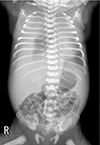Abstract
The somatostatin analog octreotide has recently been introduced in the treatment of infants with chylothorax. The safety profile of octreotide has not been fully evaluated. Octreotide reduces the splanchnic blood flow in a dose-dependent manner, affecting the entire gastrointestinal tract. Some concern has been recently raised regarding the potential implications of this effect in the development of necrotizing enterocolitis in neonates receiving octreotide for congenital hyperinsulinism or chylothorax. To our knowledge, there is no case report linking the use of octreotide with necrotizing enterocolitis in Korea. We report a case of serious necrotizing enterocolitis in a neonate treated with octreotide for congenital idiopathic chylothorax.
Figures and Tables
 | Fig. 2Infantogram (A) and abdominal ultrasonography (B) showed the findings consistent with necrotizing enterocolitis. Notable features include generalized bowel loop distension, pneumatosis coli (A, arrow), and portal venous air (B, arrows). |
 | Fig. 3Intraoperative findings were consistent with necrotizing enterocolitis involving extensive areas of jejunum, ileum, and colon. |
References
2. Ulíbarri JI, Sanz Y, Fuentes C, Mancha A, Aramendia M, Sánchez S. Reduction of lymphorrhagia from ruptured thoracic duct by somatostatin. Lancet. 1990; 336:258.

3. Au M, Weber TR, Fleming RE. Successful use of somatostatin in a case of neonatal chylothorax. J Pediatr Surg. 2003; 38:1106–1107.

4. Yin R, Zhang R, Wang J, Yuan L, Hu L, Jiang S, et al. Effects of somatostatin/ octreotide treatment in neonates with congenital chylothorax. Medicine (Baltimore). 2017; 96:e7594.
5. Rasiah SV, Oei J, Lui K. Octreotide in the treatment of congenital chylothorax. J paediatr Child Health. 2004; 40:585–588.

6. Lam JC, Aters S, Tobias JD. Initial experience with octreotide in the pediatric population. Am J ther. 2001; 8:409–415.

7. Austin JD, Hofman P, Anderson BJ. Life-threatening hyperkalemia following partial pancreatectomy for neonatal hyperinsulinism. Pediatr Crit Care Med. 2008; 9:e17–e19.

8. Reck-Burneo CA, Parekh A, Velcek FT. Is octreotide a risk factor in necrotizing enterocolitis? J pediatr Surg. 2008; 43:1209–1210.

9. Laje P, Halaby L, Adzick NS, Stanley CA. Necrotizing enterocolitis in neonates receiving octreotide for the management of congenital hyperinsulinism. Pediatr Diabetes. 2010; 11:142–147.

10. Hawkes CP, Adzick NS, Palladino AA, De León DD. Late presentation of fulminant necrotizing enterocolitis in a child with hyperinsulinism on octreotide therapy. Horm Res Paediatr. 2016; 86:131–136.

11. Mohseni-Bod H, Macrae D, Slavik Z. Somatostatin analog (octreotide) in management of neonatal postoperative chylothorax: is it safe? Pediatr Crit Care Med. 2004; 5:356–357.

12. Sivasli E, Dogru D, Aslan AT, Yurdakok M, Tekinalp G. Spontaneous neonatal chylothorax treated with octreotide in Turkey: a case report. J Perinatol. 2004; 24:261–262.

13. Paget-Brown A, Kattwinkel J, Rodgers BM, Michalsky MP. The use of octreotide to treat congenital chylothorax. J Pediatr Surg. 2006; 41:845–847.

14. Demirbilek H, Shah P, Arya VB, Hinchey L, Flanagan SE, Ellard S, et al. Long-term follow-up of children With congenital hyperinsulinism on octreotide therapy. J Clin Endocrinol Metab. 2014; 99:3660–3667.

15. Henry MC, Moss RL. Neonatal necrotizing enterocolitis. Semin Pediatr Surg. 2008; 17:98–109.
16. Martinez-Tallo E, Claure N, Bancalari E. Necrotizing enterocolitis in full-term or near-term infants: risk factors. Biol Neonate. 1997; 71:292–298.

17. Abbo O, Harper L, Michel JL, Ramful D, Breden A, Sauvat F. Necrotizing enterocolitis in full term neonates: is there always an underlying cause? J Neonatal Surg. 2013; 2:29.





 PDF
PDF ePub
ePub Citation
Citation Print
Print





 XML Download
XML Download